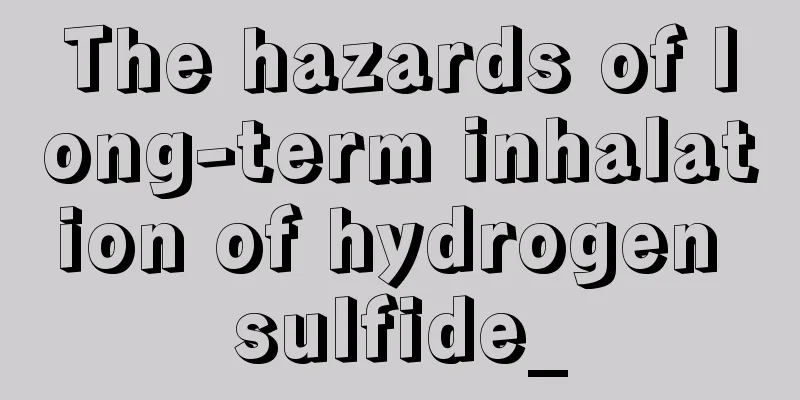The hazards of long-term inhalation of hydrogen sulfide_

|
In modern life, people's science and technology are very advanced. They can use various means to obtain some substances that were impossible to see in the past. For example, various hazardous chemicals are common things in people's lives. Among them, hydrogen sulfide, an industrial product, is a relatively important one. The amount used is very large, but it has certain toxicity and can cause adverse effects on the body. Let's take a look at whether long-term inhalation of hydrogen sulfide is harmful? What are the hazards of hydrogen sulfide to the human body? Hydrogen sulfide has irritating and cell asphyxiating effects, but because of its severe systemic toxicity and rapid onset, a more obvious irritating effect can be seen when low concentrations of hydrogen sulfide are inhaled. When high concentrations are inhaled, the olfactory nerve endings are paralyzed, causing the odor of hydrogen sulfide to "disappear", followed by coma or even death. Mild poisoning: When exposed to low concentrations (70-150 mg/m3) of hydrogen sulfide, it manifests as obvious eye and upper respiratory tract irritation symptoms, such as eye pain, tearing, photophobia, blepharospasm, blurred vision or the appearance of colored rings, runny nose, choking, chest pain, chest tightness, nausea, etc.; and there are gradually worsening systemic symptoms, such as dizziness, headache, fatigue, palpitations, difficulty breathing, cold sweat, and even fainting. At this time, if the patient is moved to a place with fresh air, the symptoms may be relieved on their own, but systemic symptoms such as headache and fatigue will take several days to gradually disappear. Moderate poisoning: When exposed to high concentrations (300-600 mg/m3) of hydrogen sulfide, chemical pneumonia and chemical pulmonary edema may occur. The patient will have difficulty breathing, chest tightness, shortness of breath, palpitations, headache, dizziness, nausea, etc., and will quickly fall into a coma from confusion. Physical examination may reveal that the patient has a grayish or cyanotic complexion, cold and clammy skin, loss of consciousness, rapid and shallow breathing, weak and frequent pulse, dull heart sounds, and dry or wet rales in the lungs; blood pressure may be normal or high at first, then decrease; pupils are often dilated, and various physiological reflexes are weakened or disappear; and body temperature is elevated. Severe poisoning: caused by inhalation of high concentrations (above 700 mg/m3) of hydrogen sulfide. In severe cases, the person may fall unconscious within seconds after inhalation, as if suffering from an electric shock, and may even suffer paralysis of the respiratory center or death. Patients often show symptoms of deep coma, whole body convulsions or rigidity, incontinence, and cold, clammy, and cyanotic skin. The pupils are dilated or constricted, all physiological reflexes disappear, breathing is shallow, rapid and irregular, scattered moist rales can be heard in the lungs, heart sounds are low and dull, and the heart rate is fast and irregular; muscle tension is often increased. Patients at this stage often have multiple complications, such as pneumonia, pulmonary edema, cerebral edema, acidosis, shock, myocardial damage, liver and kidney damage, etc. |
<<: Chinese medicine detoxification and acne removal formula
>>: Food additive glacial acetic acid
Recommend
What to do if there is a foreign object in the throat
When there is a foreign object in the throat, we ...
Causes of hypoxemia
Many people may not be particularly familiar with...
Who are the people who are not suitable for Lingzhi tea
Ganoderma tea is a very precious tea. Drinking so...
Emotional instability during menstrual period
The menstrual period is a period that women have ...
What should I do if I often have acute gastroenteritis
The stomach and intestines are relatively importa...
Normal range of heart rate after exercise and treatment of abnormal heart rate
Many of us love sports. Indeed, sports train our ...
What is artificial hair transplant?
Artificial hair transplantation is a common metho...
Can alcohol cause primary liver cancer? Key points to note when caring for liver cancer
Liver cancer is a type of cancer that causes grea...
What are the functions of alum? Most people don't know these points
Alum has good anti-inflammatory, dehumidifying, h...
12 things you shouldn't give as gifts, giving the wrong things will cause trouble
Welcoming and seeing off guests seems to be somet...
How to improve immunity during breastfeeding?
After a woman gives birth, it is like she has jus...
What are the effects and functions of white chalcedony?
There are many types of chalcedony, including whi...
What should I do if I have lower back pain and yellow vaginal discharge?
Abnormal leucorrhea is the most annoying thing fo...
What does it mean when a baby has a birthmark on his shoulder?
A person may have birthmarks on any part of the b...
What are the follow-up treatments for hemi-thyroid cancer resection?
Subsequent treatment of hemisection of thyroid ca...









